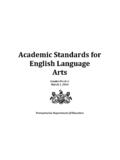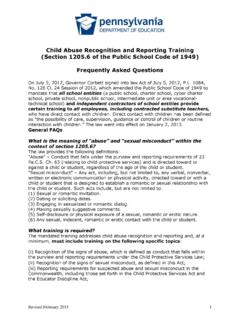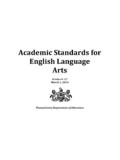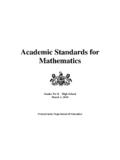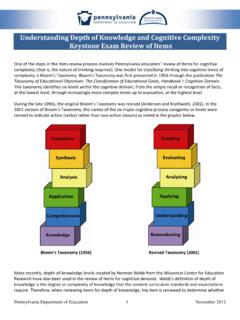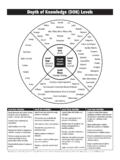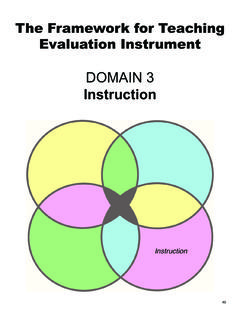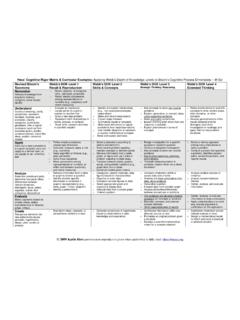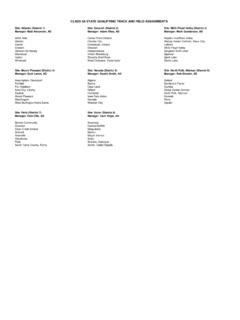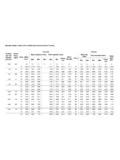Transcription of The Framework for Teaching Evaluation Instrument
1 The Framework for Teaching Evaluation Instrument DOMAIN 3. Instruction Instruction 49. 3a Communicating with Students 3a COMMUNICATING WITH STUDENTS Teachers communicate with students for several independent, but related, purposes. First, they convey that Teaching and learning are purposeful activities; they make that purpose clear to students. They also provide clear directions for classroom activities, so that students know what it is that they are to do. When teachers present concepts and information, those presen- tations are made with accuracy, clarity, and imagination; when expanding upon the topic is appropriate to the lesson, skilled teachers embellish their explanations with analogies or metaphors, linking them to students' interests and prior knowledge. Teachers occasionally withhold information from students (for example in an inquiry-based science lesson) to encour- age them to think on their own, but what information they do convey is accurate and reflects deep understanding.
2 And the teacher's use of language is vivid, rich, and error free, affording the opportunity for students to hear language well used and to extend their own vocabularies. Teacher presents complex concepts in ways that provide scaffolding and access to students. Elements of component 3a: Expectations for learning The goals for learning are communicated clearly to students. Even if goals are not conveyed at the outset of a lesson (for example, an inquiry-based lesson in science), by the end of the les- son students are clear about what they have been learning. Directions and procedures Students are clear about what they are expected to do during a lesson, particularly if they are working independently or with classmates, without direct teacher supervision. The directions for the lesson activities may be provided orally, in writing, or in some combination of the two. Explanations of content Skilled teachers, when explaining concepts to students, use vivid language and imaginative analogies and metaphors, connecting explanations to students' interests and lives beyond school.
3 The explanations are clear, with appropriate scaffolding, and, when opportunity arises, anticipate possible student misconceptions. Use of oral and written language For many students, their teachers' use of language represents their best model of both accu- rate syntax and a rich vocabulary; these models enable students to emulate such language, making their own more precise and expressive. Indicators: Clarity of the purpose of the lesson Clear directions and procedures specific to the lesson activities Absence of content errors and clear explanations of concepts Students comprehension of content Correct and imaginative use of language 50. 3a Communicating with Students Possible Examples Unsatisfactory Basic Proficient Distinguished A student asks: What The teacher mispro- The teacher says, By The teacher says: are we supposed to nounces some com- the end of today's les- Here's a spot where be doing? but the mon words.
4 Son, you're all going some students have teacher ignores the to be able to factor dif- difficulty .. be sure to The teacher says: question. ferent types of polyno- read it carefully.. And oh, by the way, mials.. The teacher states today we're going to The teacher asks a that to add fractions factor polynomials. In the course of a student to explain the they must have the presentation of con- task to other students. A student asks: What same numerator. tent, the teacher asks are we supposed to When help is needed, students: Can any- Students have a be doing? and the a student offers clarifi- one think of an exam- quizzical look on their teacher clarifies the cation about the ple of that? . faces; some may with- task. learning task to class- draw from the lesson. The teacher uses a mates. Students ask, What board or projection Students become dis- do I write here? in or- The teacher explains device so students ruptive, or talk among der to complete a passive solar energy can refer to it without themselves in an effort task.
5 By inviting students to requiring the teacher's to follow the lesson. think about the tem- Having asked stu- attention. perature in a closed The teacher uses dents only to listen, car on a cold but technical terms with the teacher says: sunny day or by the an elementary class Watch me while I. water in a hose that without explaining show you how to . has been sitting in the their meanings. A number of students sun. The teacher tends to do not seem to be fol- The teacher says: say ain't. lowing the explanation. Who would like to ex- Students are inatten- plain this idea to us? . tive during the The teacher pauses teacher's explanation during an explanation of content. of the civil rights movement to remind students that the pre- fix in, as in inequal- ity, means not and that the prefix un . means the same thing. 51. 3a COMMUNICATING WITH STUDENTS UNSATISFACTORY BASIC. The instructional purpose of the lesson is The teacher's attempt to explain the instruc- unclear to students, and the directions and tional purpose has only limited success, procedures are confusing.
6 And/or directions and procedures must be clarified after initial student confusion. The teacher's explanation of the content contains major errors. The teacher's explanation of the content may contain minor errors; some portions The teacher's spoken or written language are clear; other portions are difficult to contains errors of grammar or syntax. follow. The teacher's vocabulary is inappropriate, The teacher's explanation consists of a vague, or used incorrectly, leaving students monologue, with no invitation to the confused. students for intellectual engagement. Teacher's spoken language is correct; how- ever, his or her vocabulary is limited, or not fully appropriate to the students' ages or backgrounds. Critical Attributes At no time during the lesson does the The teacher refers in passing to what the teacher convey to the students what they students will be learning, or has written it on will be learning. the board with no elaboration or explanation.
7 Students indicate through their questions that they are confused about the learning The teacher must clarify the learning task task. so that students can complete it. The teacher makes a serious content error The teacher makes no serious content that will affect students' understanding of errors but may make a minor error. the lesson. The teacher's explanation of the content Students indicate through body language or consists of a monologue or is purely proce- questions that they don't understand the dural, with minimal participation by students. content being presented. Vocabulary and usage are correct but Teacher's communications include errors of unimaginative. vocabulary or usage. Vocabulary is too advanced or too juvenile The teacher's vocabulary is inappropriate for the students. to the age or culture of the students. 52. PROFICIENT DISTINGUISHED. The teacher clearly communicates instructional The teacher links the instructional purpose of purpose of the lesson, including where it is sit- the lesson to student interests; the directions uated within broader learning, and explains and procedures are clear and anticipate possi- procedures and directions clearly.
8 Ble student misunderstanding. Teacher's explanation of content is well scaf- The teacher's explanation of content is folded, clear and accurate, and connects with thorough and clear, developing conceptual students' knowledge and experience. understanding through artful scaffolding and connecting with students' interests. During the explanation of content, the teacher invites student intellectual engagement. Students contribute to extending the content and help explain concepts to their classmates. Teacher's spoken and written language is clear and correct and uses vocabulary appropriate The teacher's spoken and written language is to the students' ages and interests. expressive, and the teacher finds opportunities to extend students' vocabularies. The teacher states clearly, at some point dur- In addition to the characteristics of proficient : ing the lesson, what the students will be The teacher points out possible areas for mis- learning.
9 Understanding. If the tactic is appropriate, the teacher models Teacher explains content clearly and imagina- the process to be followed in the task. tively, using metaphors and analogies to bring Students engage with the learning task, content to life. indicating that they understand what they are All students seem to understand the presenta- to do. tion. The teacher makes no content errors. The teacher invites students to explain the The teacher's explanation of content is clear content to the class or to classmates. and invites student participation and thinking. Teacher uses rich language, offering brief The teacher's vocabulary and usage are cor- vocabulary lessons where appropriate. rect and completely suited to the lesson. The teacher's vocabulary is appropriate to the students' ages and levels of development. 53. Charlotte Danielson The Framework for Teaching Evaluation Instrument 2011 The Danielson Grou
